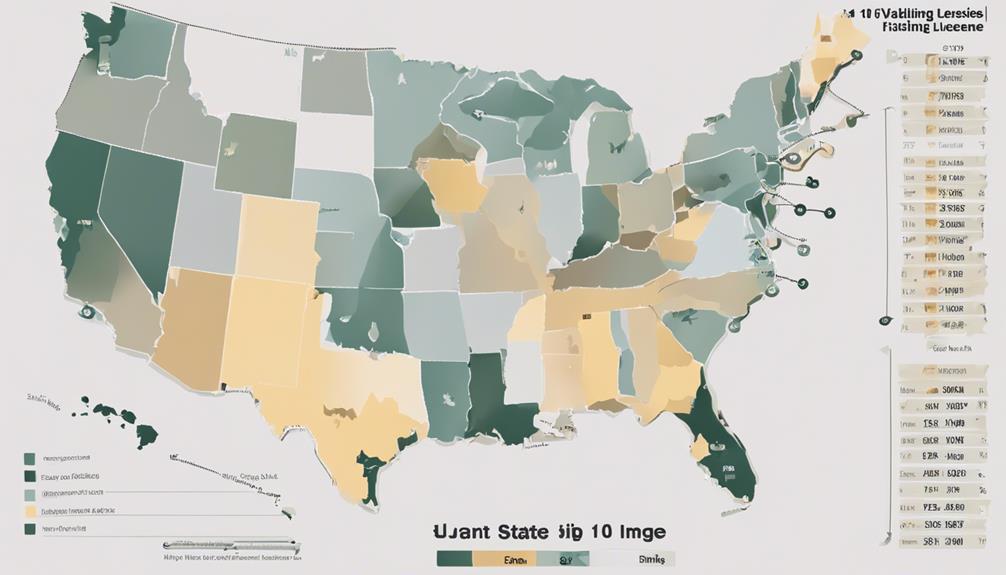In the vast ocean of conservation efforts, fishing regulations serve as a lifeboat for endangered species, guiding them away from the treacherous waters of extinction.
Imagine a world where the delicate balance of marine ecosystems is disrupted, and species vanish silently beneath the waves.
But why should you care about fishing regulations and their impact on endangered species?
The answer lies in the intricate web of connections that sustain life on our planet, a web that can unravel with the slightest disturbance.
Importance of Fishing Regulations
Understanding the importance of fishing regulations is crucial for protecting endangered species and maintaining a sustainable ecosystem. By implementing sustainability practices, such as catch limits and size restrictions, fishing regulations aim to minimize the environmental impact on vulnerable species. These regulations help ensure that fish populations remain stable and healthy, preserving the delicate balance of marine ecosystems.
Community involvement plays a significant role in the success of fishing regulations. Engaging stakeholders, including local fishermen, conservation groups, and government agencies, fosters a sense of responsibility and ownership. When communities are actively involved in the decision-making process, there's greater compliance and support for the regulations in place.
Effective fishing regulations not only protect endangered species but also benefit the overall health of the ecosystem. By preventing overfishing and bycatch, these regulations help maintain biodiversity and promote sustainable fishing practices. Through community engagement and stakeholder involvement, fishing regulations can be tailored to address specific conservation needs while considering the livelihoods of those dependent on fishing.
Impact on Endangered Species
To comprehend the impact of fishing regulations on endangered species, consider the crucial role these measures play in protecting vulnerable marine populations. Fishing regulations are essential for safeguarding endangered species by ensuring habitat protection and promoting sustainable practices. These regulations help prevent overfishing in critical habitats where endangered species reside, allowing populations to recover and promoting species survival.
- Habitat Protection: Fishing regulations establish areas where endangered species can thrive without human interference. By limiting fishing activities in these designated zones, the regulations help maintain essential habitats for endangered species, allowing them to reproduce and grow their populations.
- Sustainable Practices: Implementing fishing regulations encourages the adoption of sustainable fishing practices. By setting catch limits, regulating fishing methods, and enforcing seasonal restrictions, these measures ensure that fishing activities don't deplete endangered species populations beyond their capacity to recover.
- Population Recovery and Species Survival: Fishing regulations contribute significantly to the recovery of endangered species populations. By controlling fishing pressure and reducing bycatch, these regulations enable endangered species to increase their numbers and improve their chances of long-term survival in their natural habitats.
Conservation Efforts Through Regulations
Conservation efforts are strengthened through the implementation of stringent fishing regulations aimed at protecting endangered species and preserving their habitats. By enforcing regulations that limit fishing activities in sensitive areas or during critical breeding seasons, authorities can directly impact the survival and recovery of endangered species. These regulations not only safeguard the populations of fish at risk but also contribute to the overall health of marine ecosystems.
Community involvement plays a crucial role in the success of conservation efforts through fishing regulations. When local communities actively participate in decision-making processes and enforcement activities, there's a greater sense of ownership and responsibility towards protecting endangered species. By engaging with stakeholders, sharing knowledge about the importance of conservation, and promoting sustainable fishing practices, authorities can ensure long-term support for regulations aimed at preserving biodiversity.
Sustainability practices are key components of effective fishing regulations designed to protect endangered species. By promoting sustainable fishing methods such as catch-and-release, size limits, and gear restrictions, authorities can minimize the impact of fishing activities on vulnerable populations. These practices not only help conserve endangered species but also maintain the balance of marine ecosystems for future generations to enjoy. Through a combination of strict regulations, community involvement, and sustainable practices, conservation efforts can make a significant difference in safeguarding endangered species and their habitats.
Role of Fishing Licenses
Strengthening the oversight of fishing activities, fishing licenses play a crucial role in enforcing regulations to protect endangered species and their habitats. By requiring fishermen to obtain licenses, authorities can monitor and control fishing practices more effectively, ensuring that endangered species aren't being targeted or harmed. Here's why fishing licenses are essential for sustainable management and conservation funding:
- Regulating Fishing Effort: Fishing licenses help limit the number of fishermen operating in specific areas, preventing overfishing that can have detrimental effects on endangered species populations. By controlling the fishing effort through licensing, authorities can maintain a balance that supports both the fishing industry and conservation efforts.
- Monitoring Compliance: Fishing licenses come with regulations that fishermen must adhere to, such as catch limits and gear restrictions. These rules help protect endangered species by reducing accidental bycatch and ensuring that fishing practices are sustainable. Regular checks and audits of licensed fishermen can help monitor compliance with these regulations.
- Generating Revenue for Conservation: The fees collected from fishing licenses can be allocated towards conservation programs and initiatives aimed at protecting endangered species and their habitats. This conservation funding is crucial for conducting research, implementing conservation strategies, and raising awareness about the importance of preserving biodiversity in marine ecosystems.
Enforcement of Regulations
Enforcing fishing regulations is vital for safeguarding endangered species and their habitats. Compliance challenges often arise due to factors like lack of awareness or intentional disregard for the rules. To tackle this, effective monitoring strategies are crucial. Monitoring can involve the use of technology such as GPS tracking, drones, or underwater cameras to ensure compliance with regulations in fishing hotspots.
Legal implications play a significant role in enforcing fishing regulations. Penalties for non-compliance can range from fines to license revocation, depending on the severity of the offense. By strictly enforcing these consequences, authorities send a clear message about the importance of adhering to regulations that protect endangered species.
Community engagement is another key aspect of enforcement. By involving local communities in monitoring efforts and educating them about the importance of conservation, authorities can increase compliance and foster a sense of responsibility towards protecting endangered species. This engagement can also lead to the development of community-led conservation initiatives, further strengthening the enforcement of fishing regulations.
Benefits for Ecosystems
Regularly monitoring fishing activities can lead to noticeable improvements in the health and balance of ecosystems. By enforcing fishing regulations, you play a crucial role in safeguarding the delicate interplay of species and habitats. Here's why biodiversity preservation and ecosystem balance benefit from these measures:
- Biodiversity Preservation: Fishing regulations help maintain the variety of species within an ecosystem. By controlling which species can be caught and how many, these rules prevent overfishing of certain populations. This preservation of biodiversity is vital for the resilience and adaptability of ecosystems to environmental changes.
- Ecosystem Balance: Protecting habitats through fishing regulations ensures that the ecosystem remains in equilibrium. By limiting fishing in specific areas or during sensitive times, such as breeding seasons, you contribute to the overall health of the ecosystem. This balance is essential for the survival of various species and the stability of the entire ecosystem.
- Habitat Protection: Fishing regulations often include restrictions on gear types or fishing methods to reduce habitat destruction. By safeguarding crucial habitats like coral reefs, seagrass beds, or spawning grounds, these regulations support not only the targeted species but also countless others that rely on these habitats for food and shelter.
Your efforts in adhering to fishing regulations have far-reaching benefits beyond just individual species' survival—they help maintain the intricate web of life in our oceans.
Preventing Overfishing

To prevent overfishing, it's crucial to implement strict catch limits and monitoring systems. By setting clear boundaries on how much can be caught, we can ensure that fish populations have the opportunity to replenish and thrive. Monitoring systems help track fishing activities, making sure that limits are adhered to and providing valuable data for future conservation efforts. These measures are essential to safeguarding endangered species and maintaining the delicate balance of aquatic ecosystems.
Overfishing can have a devastating economic impact on communities that rely on fishing for their livelihoods. When fish stocks decline due to excessive fishing, not only are species at risk, but fishermen also suffer from reduced catches and income. Implementing sustainable practices through regulated fishing can help prevent these negative consequences. By protecting fish populations from depletion, we can ensure a more stable income for fishermen in the long term.
Sustainable fishing practices not only benefit the environment and endangered species but also contribute to the overall health of marine ecosystems. By avoiding overfishing, we allow fish populations to recover and play their vital roles in the ocean food chain. It's essential to strike a balance between harvesting fish for consumption and ensuring their populations remain healthy for future generations to enjoy.
Future of Endangered Species
Looking ahead, ensuring the survival of endangered species requires proactive conservation efforts and sustainable management strategies. To secure a better future for these vulnerable creatures, it's essential to focus on the following key aspects:
- Species Protection: Embracing advanced technology is crucial for effectively monitoring and safeguarding endangered species. Implementing tools such as GPS tracking devices, drones, and satellite imagery can aid in tracking populations, identifying critical habitats, and deterring poaching activities. By integrating technology into conservation practices, experts can gather real-time data to make informed decisions and tailor protection strategies to the specific needs of each species.
- Sustainable Practices: Encouraging sustainable practices among communities and industries is vital for the long-term survival of endangered species. Promoting responsible fishing methods, habitat preservation, and land-use planning can help mitigate human impact on vulnerable ecosystems. Through education and outreach programs, individuals can learn about the importance of biodiversity and the role they play in preserving it. By fostering a culture of sustainability, we can create a more harmonious relationship between human activities and the natural world.
- Education: Educating the public about endangered species and the threats they face is fundamental in garnering support for conservation efforts. Increasing awareness through school programs, public campaigns, and community initiatives can inspire individuals to take action to protect biodiversity. By instilling a sense of stewardship and empathy towards endangered species, we can cultivate a society that values and prioritizes wildlife conservation for generations to come.
Frequently Asked Questions
How Do Fishing Regulations Differ Between Freshwater and Saltwater Environments?
When it comes to fishing regulations, freshwater and saltwater environments have different rules in place. Freshwater regulations focus on protecting habitats and specific species, while saltwater regulations often aim to manage commercial fishing operations and ensure sustainable practices.
Both sets of regulations play a critical role in minimizing the environmental impact of fishing activities and supporting conservation efforts for endangered species. It's essential to follow these rules to safeguard our marine ecosystems for future generations.
What Are Some Common Challenges Faced by Enforcement Agencies in Ensuring Compliance With Fishing Regulations?
Enforcement challenges can arise due to the vast expanses of water to monitor. Illegal fishing techniques like poaching or using prohibited gear make it tricky to catch violators.
Maintaining a presence in remote areas and keeping up with evolving technology are ongoing obstacles for agencies. Balancing the need for conservation with the economic interests of fishermen adds complexity to enforcement efforts.
Vigilance and cooperation are key in tackling these challenges effectively.
Are There Any Specific Fishing Techniques or Gear Types That Are Particularly Harmful to Endangered Species?
To protect endangered species, it's vital to address harmful fishing techniques. Bycatch prevention and habitat protection are crucial. Some gear types, like bottom trawls or gillnets, pose significant threats to these species.
Sustainable practices and gear restrictions can help mitigate these risks. Implementing regulations that focus on these factors can safeguard endangered species and promote a healthier marine ecosystem.
How Do International Treaties and Agreements Impact Fishing Regulations for Endangered Species?
When considering international treaties and agreements, you'll find that they play a vital role in shaping fishing regulations for endangered species. Through international cooperation, conservation efforts are strengthened, ensuring the protection of vulnerable marine life.
These agreements also promote economic incentives for adopting sustainable fishing practices, which ultimately benefit both the environment and local communities that rely on these resources. So, by adhering to these treaties, you contribute to the preservation of our planet's biodiversity.
What Role Do Recreational Anglers Play in Supporting Conservation Efforts for Endangered Species Through Fishing Regulations?
When it comes to supporting conservation efforts for endangered species through fishing regulations, recreational anglers play a crucial role. Recreational involvement can lead to conservation partnerships and initiatives that help protect vulnerable species.
Conclusion
In conclusion, fishing regulations are crucial for protecting endangered species. By implementing and enforcing these regulations, we can help ensure the survival of vulnerable species and promote a healthy ecosystem.
Conservation efforts through regulations, such as fishing licenses and preventing overfishing, play a vital role in the future of endangered species. It's important for all individuals to follow these regulations to help safeguard the biodiversity of our planet for generations to come.



